20 Minute Vegan Pesto Pasta
This vegan pesto pasta recipe is full of bright, fresh flavors. If you’re looking for a simple weeknight dinner, you’ll love this recipe!
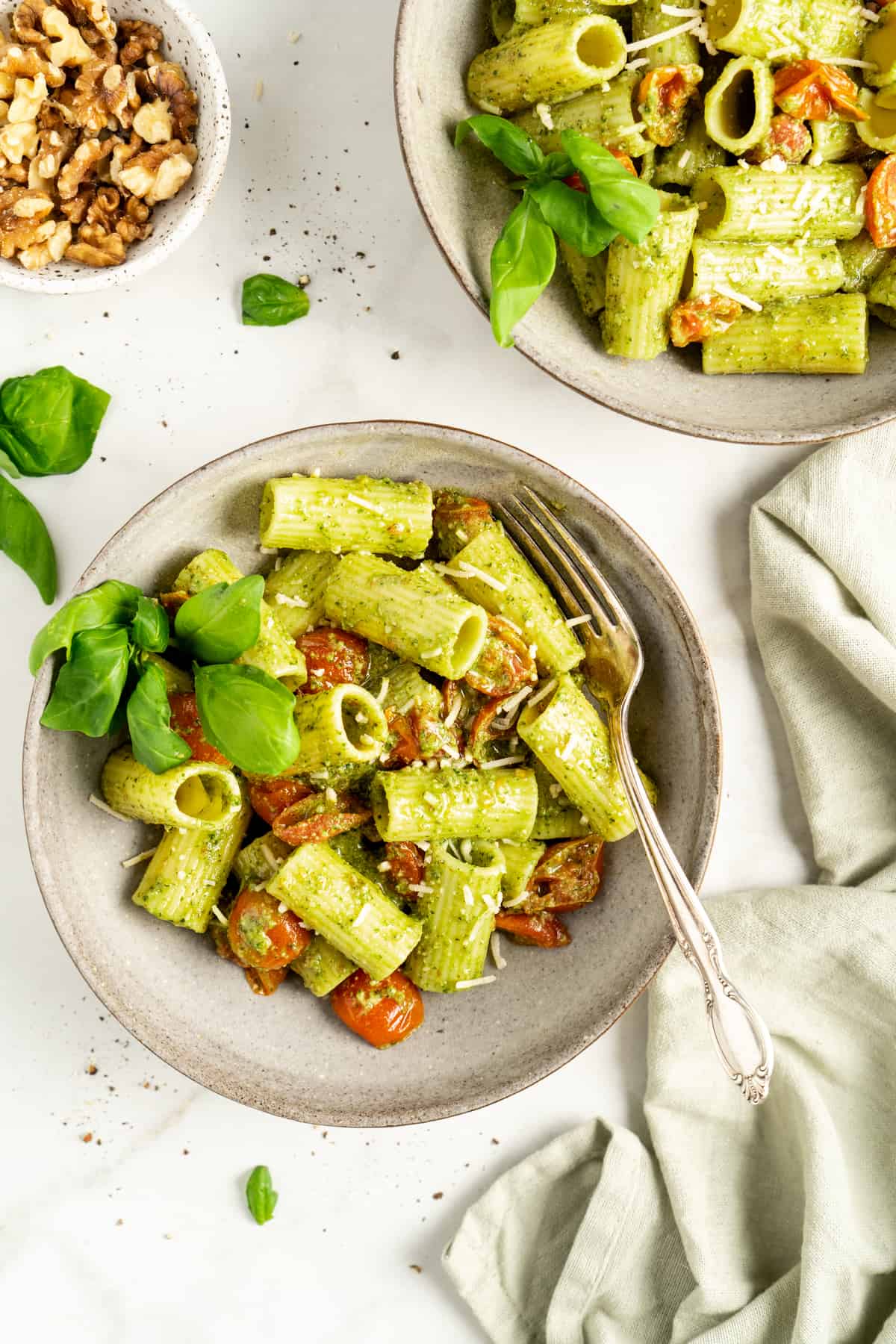
I love exploring new flavors and ideas, but there’s something to be said for those classic, go-to recipes you return to again and again. Pesto pasta is definitely one of those dishes. It’s easy to make, perfect for customizing, and it’s always packed with flavor. Even though it takes minutes to whip up for a weeknight dinner, it somehow always makes me feel like I’m eating a meal from a fancy Italian restaurant.
I’ve made many a pesto pasta before, and many different kinds of pestos. Below, I include a basil pesto recipe made with walnuts and vegan Parmesan, but if you want to switch things up, you can choose from parsley pesto, or kale pistachio pesto, a more classic basil pesto or a creamy cashew pea pesto for something different. If you’re pressed for time, you can also use a store-bought pesto or one from the farmer’s market, which is totally okay too. Food is supposed to work for you, not the other way around!
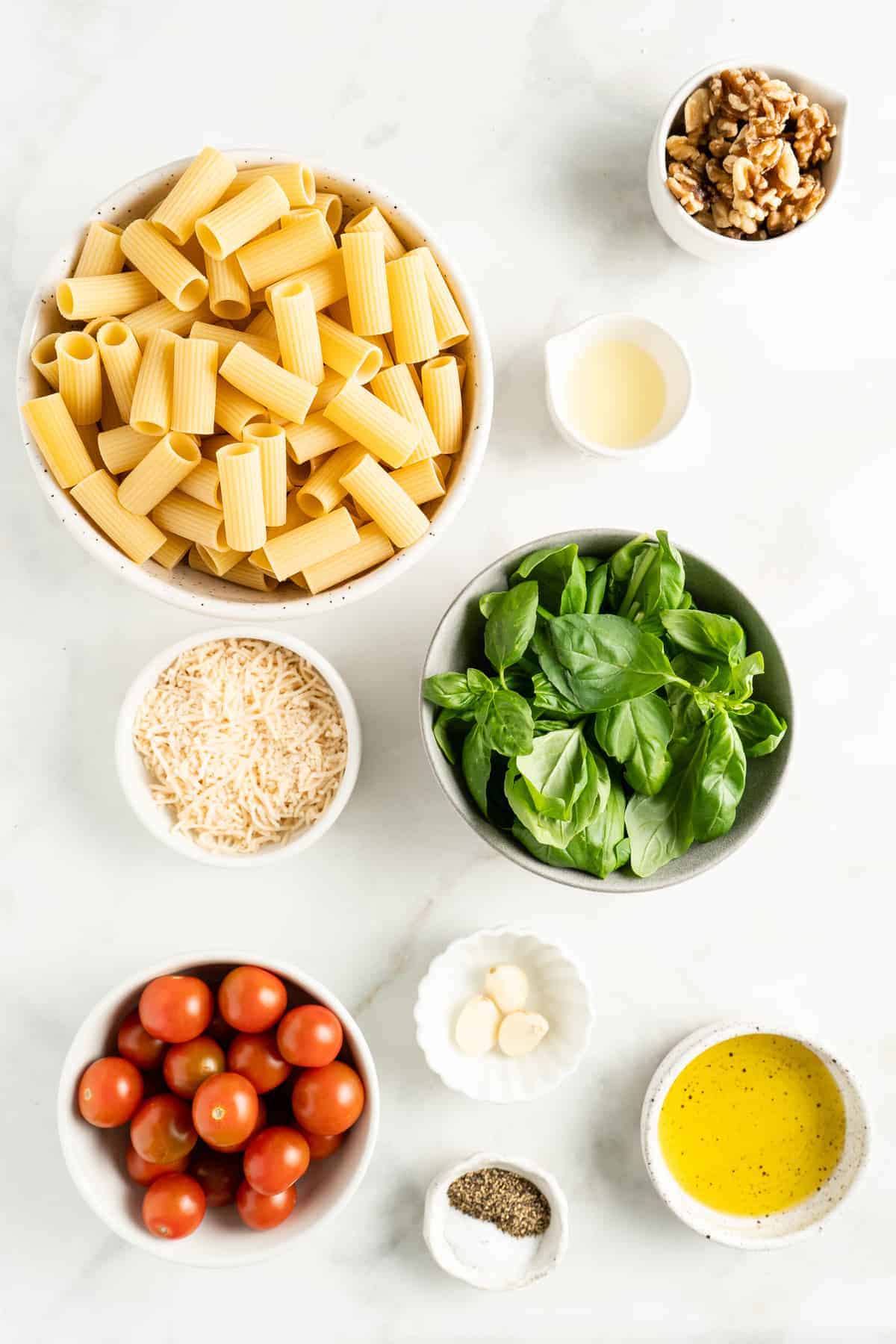
Notes on Ingredients
Please note that this is important information on the ingredients and instructions and the FULL recipe with amounts and details can be found DOWN BELOW (scroll to it) in the recipe card.
For the vegan basil pesto:
- Basil – Buy fresh looking leaves without any dark spots or sliminess.
- Raw walnuts – If you like, you can toast them to bring out their flavor.
- Vegan parmesan cheese – Here’s how to make your own vegan parmesan.
- Garlic
- Lime juice – Swap with lemon for a more traditional pesto.
- Sea salt
- Olive oil
- Pepper
For the pasta and tomatoes:
- Pasta – Use any variety you like, but fusilli, rigatoni, rotini, and cavatappi are all great for “gripping” the pesto.
- Pesto – you can use store-bought or my homemade recipe! Double check your store-bought pesto that it’s vegan; most contain parmesan cheese.
- Vegan heavy cream – for added creaminess! You can use store-bought or my homemade recipe! This is a new addition to this recipe so it isn’t in the ingredient photo above.
- Pasta water – You’ll have to remember to reserve it before you drain the pasta. (Anyone else always forget to do that?!)
- Coconut oil – Olive oil will work, too.
- Grape or cherry tomatoes – Feel free to swap this with your favorite seasonal veggies.
- Salt and pepper
- Vegan parmesan – For serving with your pasta.
How to Make Vegan Pesto Pasta
Here’s a step-by-step guide to making pesto pasta:
Cook the pasta. Bring a pot of salted water to a boil and cook the pasta according to the package instructions.
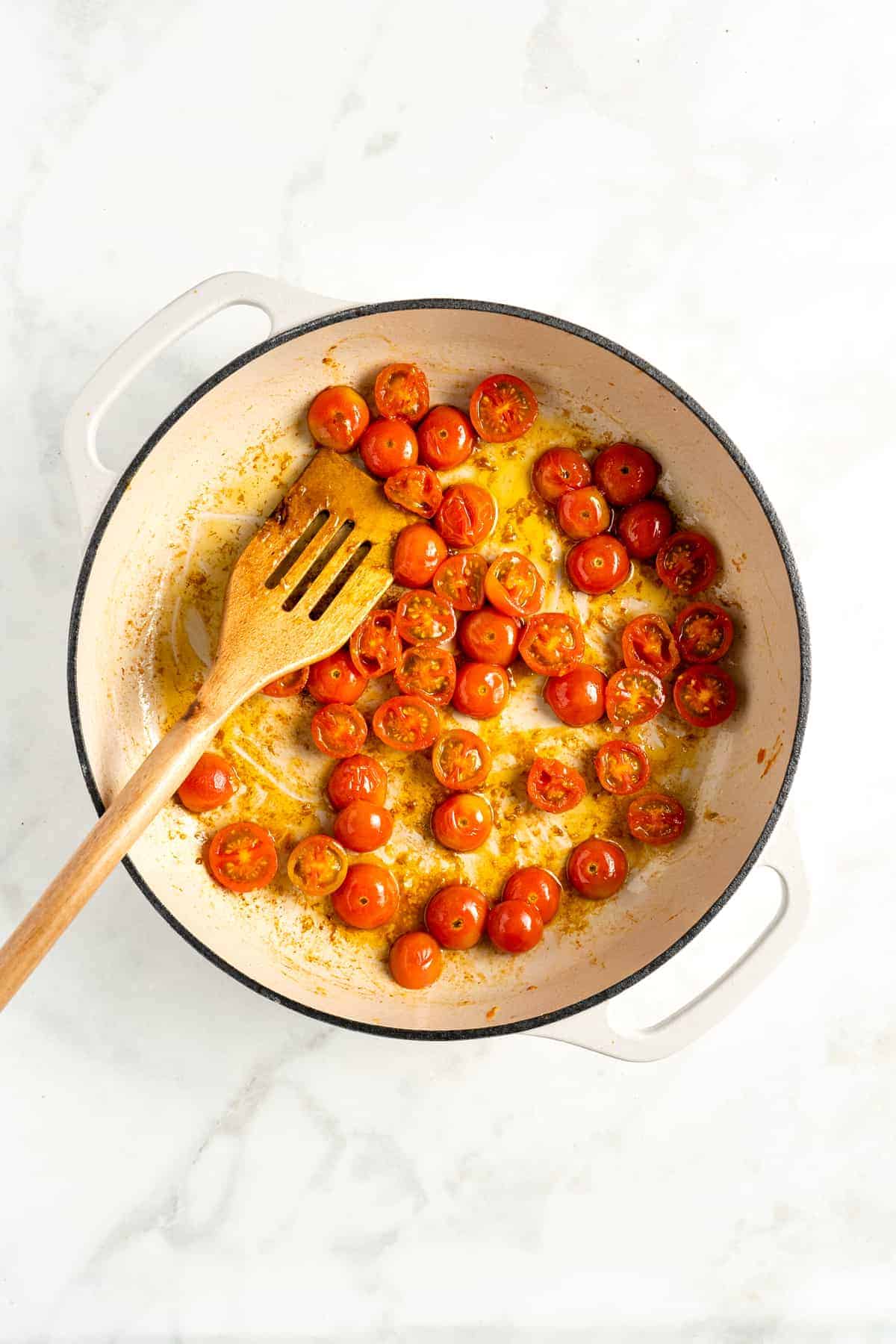
Cook the tomatoes. While you’re cooking the pasta, place a skillet over medium heat and melt the coconut oil. Add the tomatoes, and cook, stirring often, until they’re cooked down and burst, about 5 minutes.


Make the pesto. Add all of the pesto ingredients into a food processor or high powered blender and process until the mixture reaches your desired consistency, scraping down sides if needed. You can store any excess in a jar, and use what you need for the dish.
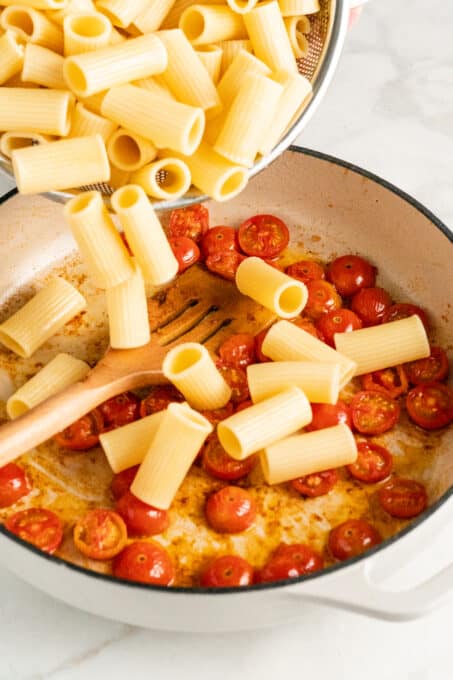

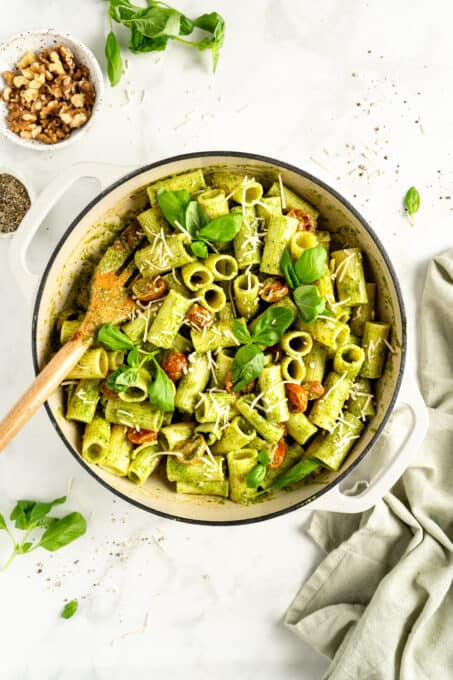
Finish the pasta. Drain the pasta, reserving some of the cooking water. Add the pasta to the skillet with the tomatoes, then add the pesto and stir to coat. If the pesto seems too thick, you can add some of the cooking liquid. Divide into bowls or plates and garnish with vegan Parmesan.
Tips for Success
This recipe is perfect for beginning cooks, but I have a few tips to help you along the way:
- Don’t be afraid to add a lot of oil. One mistake a lot of people make with pesto is skimping on the oil. The result is a thick, paste-like mixture that doesn’t coat the pasta. For a smooth, creamy pesto, you have to be liberal with the oil!
- Customizing the texture. When processing the pesto, you can stop once all of the ingredients are finely chopped for a more rustic feel, or you can keep going until the ingredients are completely pureed. It’s up to you, but it’s good either way!
- About the nuts. I use walnuts, but cashews, pine nuts, and walnuts can all be used to make pesto, too. If you’re allergic to nuts, try using hemp seeds instead.
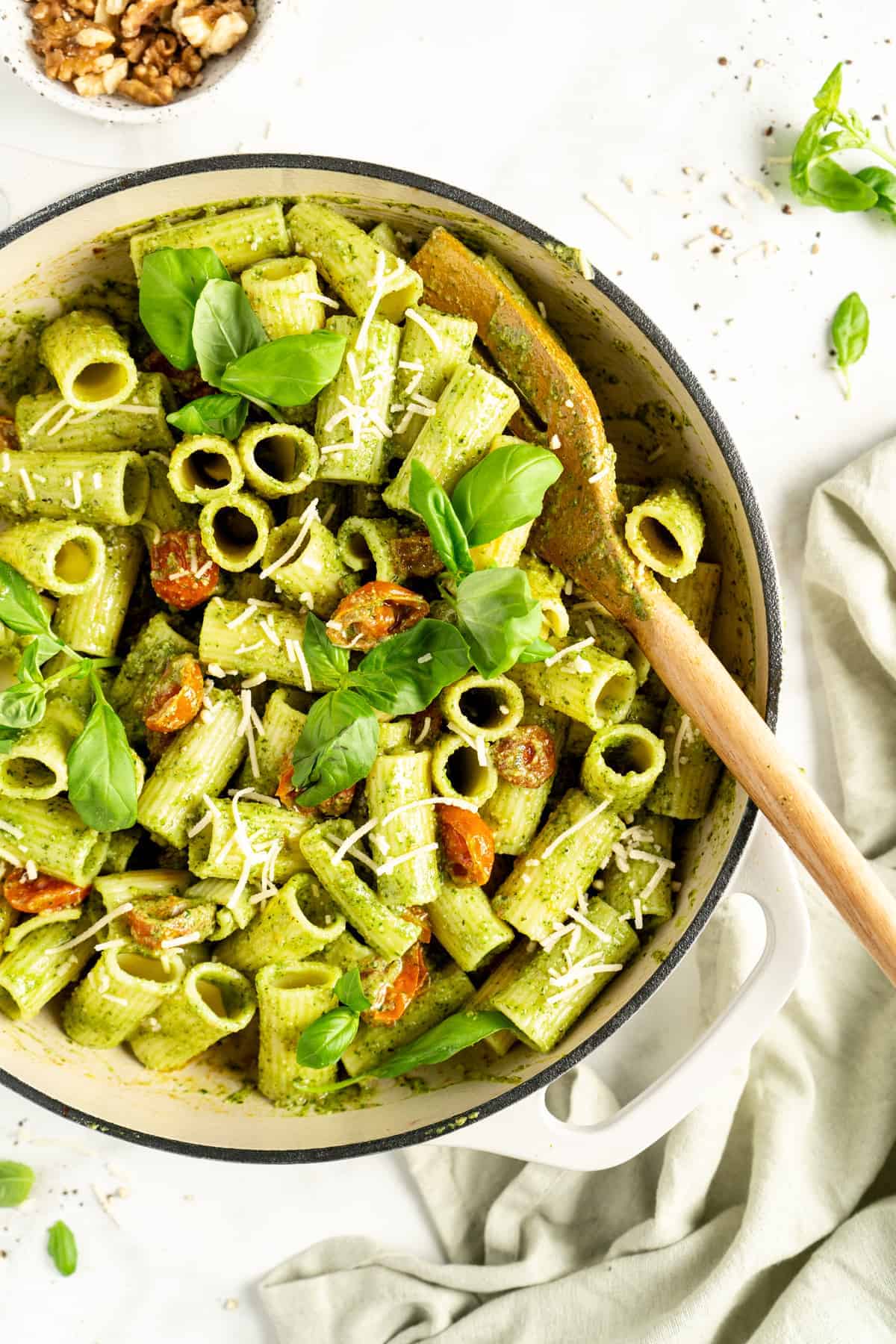
How to Store and Reheat Leftovers
If you have leftover pesto pasta, pop it in an airtight container and keep it in the refrigerator for up to 3 days. You can either reheat it in the microwave until it’s warmed through, or place it in a skillet and warm it over medium heat.
Can I Freeze Pesto?
Yes, you can freeze pesto—in fact, I recommend that you do! I love keeping a variety of pestos on hand in the freezer for quick weeknight dinners. For individual portions, freeze your pesto in an ice cube tray, then transfer the cubes to a freezer bag. To freeze a big batch, transfer the pesto to a freezer bag, press out the air, and freeze it flat in your freezer. When you’re ready to use it, you can either thaw the pesto in the refrigerator or place the freezer bag in a bowl of hot water until it thaws.
Enjoy friends! If you make this vegan pesto pasta, please snap a photo and tag #jessicainthekitchen on Instagram! We’d also love it if you would leave a comment below, and give the recipe a rating! Thanks so much!
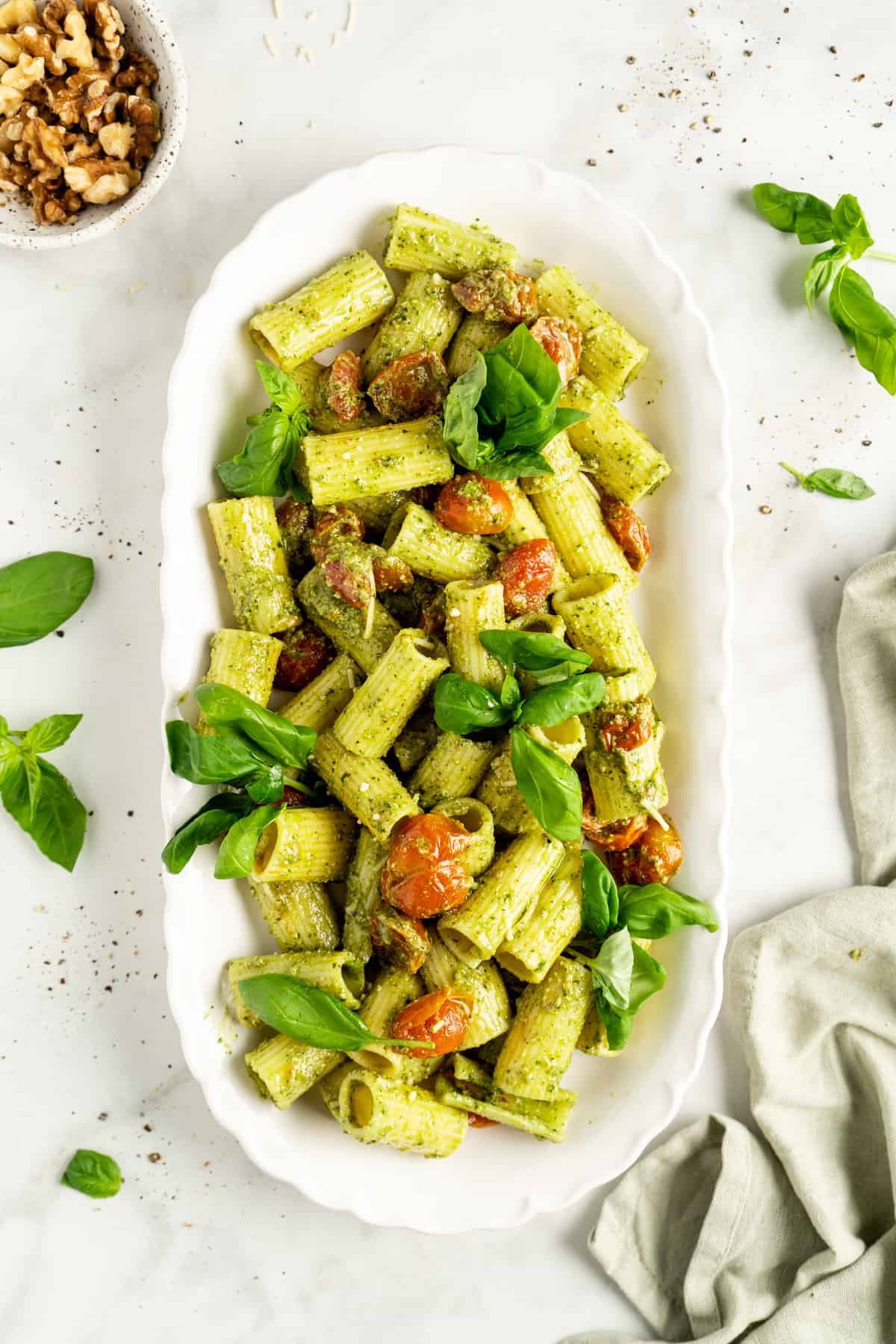
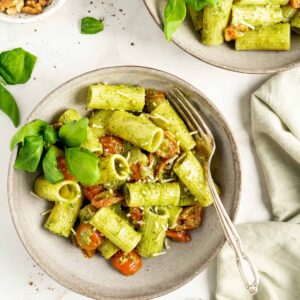
20 Minute Vegan Pesto Pasta
Ingredients
Pasta and tomatoes
- 8 ounces pasta
- ½ tablespoon coconut oil
- 2 cups grape tomatoes, or cherry tomatoes, sliced
- Salt and pepper to taste
- 2-4 tablespoons vegan heavy cream, or vegan creamer, or unsweetened non-dairy milk
- 3 tablespoons vegan Parmesan cheese, homemade or store-bought plus more for garnish
- ½ to ¾ cup pesto, homemade – below or store-bought
- 2-4 tablespoons pasta water
Basil Pesto
- 2 ½ cups basil, stemmed and washed
- ⅓ cup walnuts, raw
- 2 tablespoons vegan Parmesan cheese
- 3 cloves garlic
- 1 tablespoon lime juice
- ½ teaspoon sea salt
- ⅓ cup olive oil, up to 1/2 cup
- 1/2 teaspoon pepper, adjust to taste
Instructions
- Bring a pot of salted water to a boil. Cook the pasta to the box or package’s directions.
- While the pasta is boiling, heat the coconut oil in a pan over medium high heat. When hot, add in the tomatoes, stirring and sautéing until the tomatoes are cooked down and burst, about 5 minutes. Season with sea salt and black pepper.
- While the tomatoes, are cooking down, prepare the pesto.
- Add all the ingredients into a food processor or high powered blender and press the sauce/spread button or blend until combined smoothly, scraping down sides if necessary. Pour the excess into a jar, and use ½ to ¾ cup for the dish.
- Strain the cooked pasta, saving a few tablespoons of pasta water if the pesto is too thick on the pasta. Add in the vegan heavy cream and the pasta to the pan with the tomatoes, the vegan parmesan cheese, and then pour the pesto on, stirring in. Add the pasta water if necessary.
- Taste and add more sea salt if needed. Serve with some extra vegan parmesan on the side and enjoy!
Notes
- Don’t be afraid to add a lot of oil. One mistake a lot of people make with pesto is skimping on the oil. The result is a thick, paste-like mixture that doesn’t coat the pasta. For a smooth, creamy pesto, you have to be liberal with the oil!
- Customizing the texture. When processing the pesto, you can stop once all of the ingredients are finely chopped for a more rustic feel, or you can keep going until the ingredients are completely pureed. It’s up to you, but it’s good either way!
- About the nuts. I use walnuts, but cashews, pine nuts, and walnuts can all be used to make pesto, too. If you’re allergic to nuts, try using hemp seeds instead.
Disclaimer: Although jessicainthekitchen.com attempts to provide accurate nutritional information, kindly note that these are only estimates. Nutritional information may be affected based on the product type, the brand that was purchased, and in other unforeseeable ways. Jessicainthekitchen.com will not be held liable for any loss or damage resulting for your reliance on nutritional information. If you need to follow a specific caloric regimen, please consult your doctor first.




what can I use as a substitute for vegan parm, if I just skip that step will it alter the taste? I can’t eat yeast and a lot of recipes call for nutritional yeast 🙁
Hi Danielle!!
You can buy vegan parmesan cheese too! https://rstyle.me/n/c59kdqbek9f Based on the ingredients it doesn’t look like their is any yeast in this. It tastes much more like parmesan cheese, and is easy to acquire. Alternatively, if you leave out the parmesan cheese, it will alter the taste but won’t make it taste bad, it just won’t be as flavourful. You can try it without it anyway and see if you still like it! I hope that helps!
I’m trying to make 2 large trays of this. Can you help me size the recipe up please?
Hi Jasmine! Sure happy to help how many people are you preparing it for?
~60 people–I’m also having Lasagna, bread, salad, and soup
Hi jasmine this is enough to feed 40 people based on your other dishes.
80 oz of pasta
5 cups of pesto
2 cups pasta water
5 tablespoons coconut oil
20 cups grapes sliced
1 1/2 cups minimum vegan part for the top
pesto-
25 cups basil
3 1/3 cups walnuts
1 1/4 cup vegan parmesan
30 cloves of garlic
10 tablespoons lime juice
1 2/3 tablespoon course salt
3 1/3 cups olive oil
1 2/3 tablespoon black pepper
I hope this helps!
if this is too much we can scale it down some more
Made this for dinner tonight with garden fresh tomatoes and basil. Added garlic to the tomatoes while cooking. Otherwise, made to directions. Maybe next time I would add half the lemon juice and adjust to taste. But really good. Even made the parm cheese. Will definitely make again.
Wow thanks Sylvia we’re glad you like it. I’m so happy that you’ll be making it again as well! Have a great day and thanks for reading!
Hi Jessica I made a Homemade Jamaican Jerk Sauce I used to this ingredients If you add something could you send reply on message me please.
1/2 Cup Ground All spice
1/2 Cup Packed brown sugar
6 to 8 garlic cloves
4 to 6 scootch bonnet peppers ( I used to dry chili arefacta peppers but why I bought because I couldn’t find scootch bonnet peppers this pepper looks like little
bit scootch bonnet peppers but it’s not chili interesting anyway. When I will be makes this sauce again I will find this scootch bonnet peppers hopefully.)
1 tablespoon ground thyme
2 bunches scallions
1/2 teaspoon nutmeg
1 tablespoon each Salt and black peppers but ( I needed to use kosher salt and ground black pepper I hadn’t a both I used to normal salt and black pepper )
2 tablespoons soy sauce
Would you any recommend please send reply on message me. Cheers
Hi Umut we recommend this jerk sauce https://jessicainthekitchen.com/jamaica-jerk-sauce-homemade-and-easy/ I hope you have a great day.
My granddaughter is allergic to tree nuts. Would I be able to substitute the walnuts with anything?
Hi Deb, you can soak sunflower seeds and use that instead!